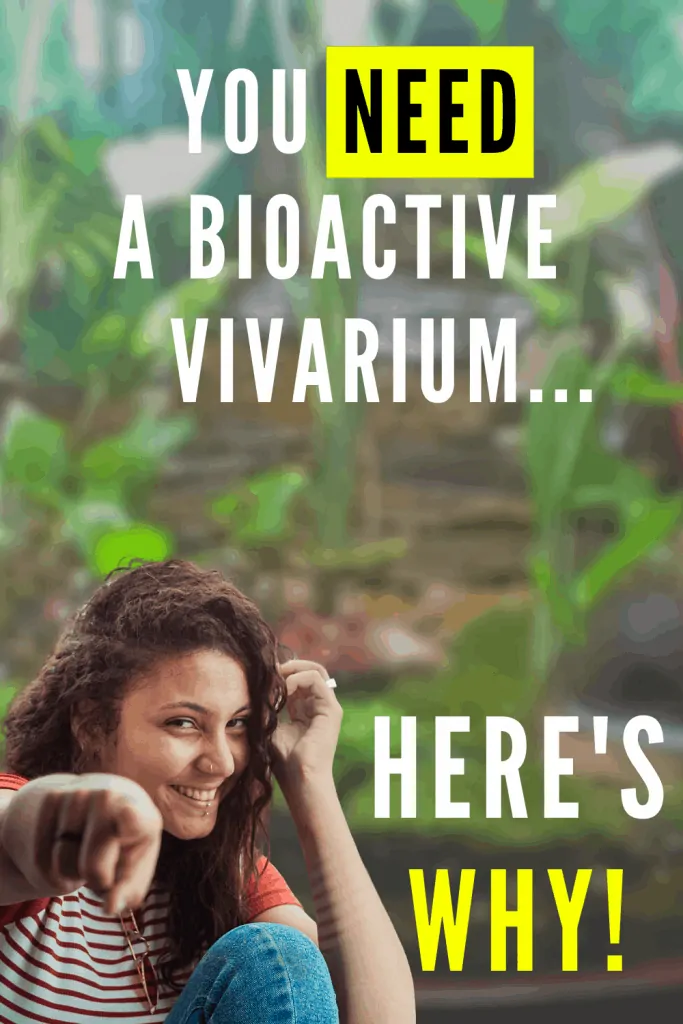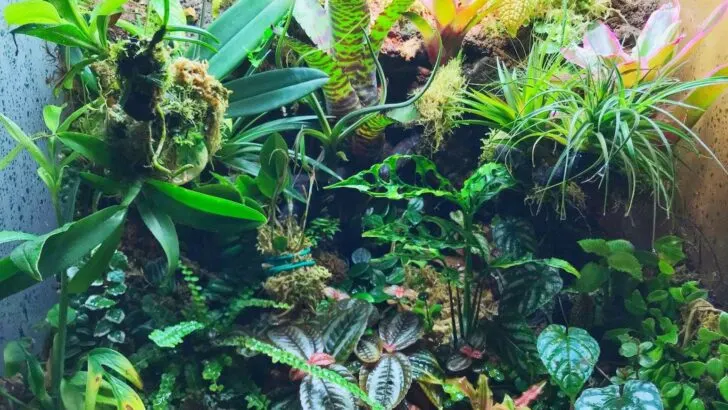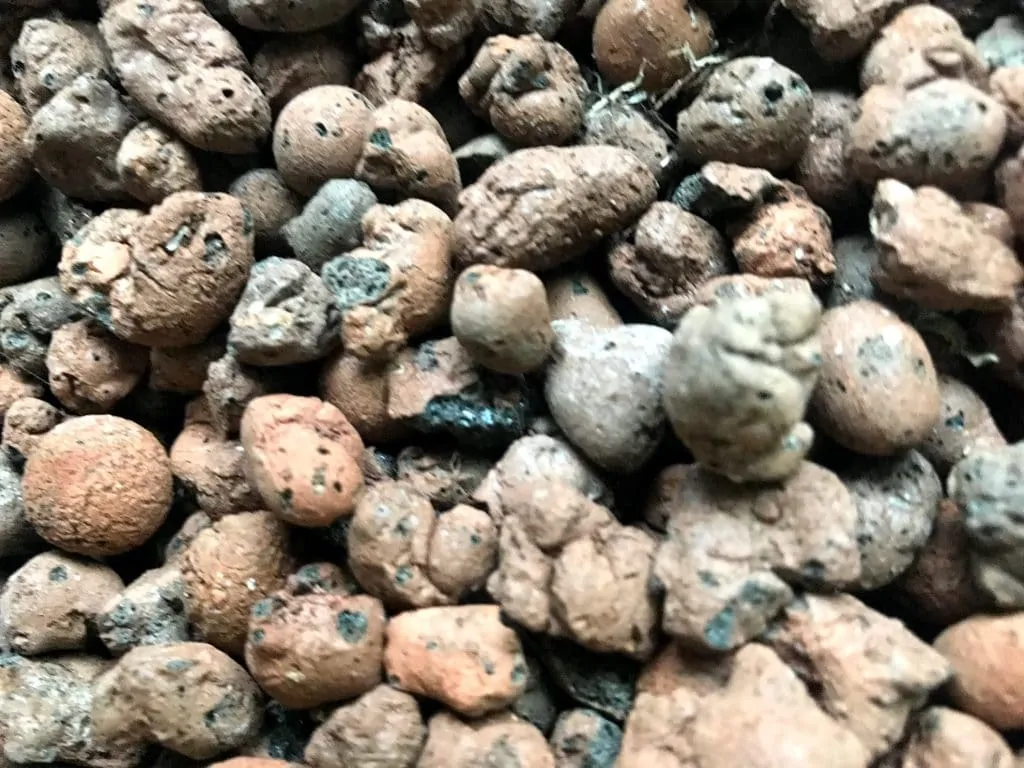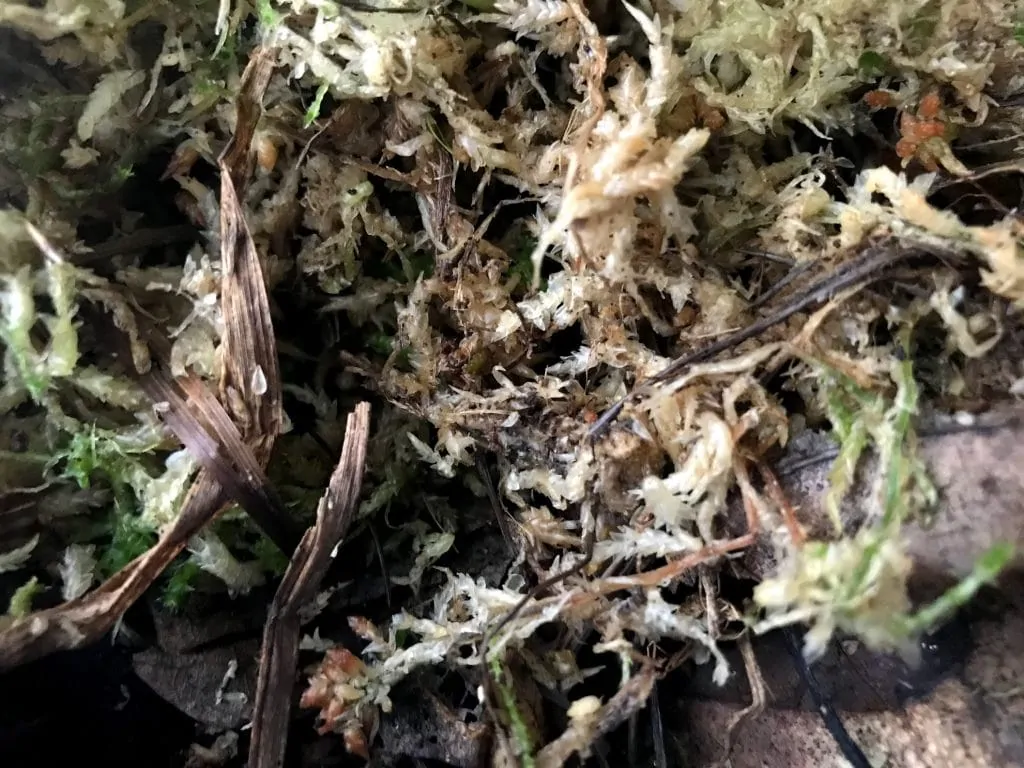Why would you need a Bioactive Vivarium?
Let’s face it. Keeping plants can be demanding.
You need to ensure that temperatures, humidity, and the composition of the soil are right. In addition, every plant has specific watering needs.
All these things need to be right to keep your plants happy. Specifically, if you are dealing with more tropical plants, humidity needs to become a big topic. Some plants require 80% humidity or more.
It is therefore not surprising, that some plants are best kept in a Bioactive Vivarium where you can easily control the level of humidity.
But with increasing humidity and reduced airflow, you are also creating the ideal circumstances for the mold to build.
In addition, as you will spray your plants daily or multiple times a day, root rot might become an issue. But there is light at the end of the tunnel.
Bioactive Vivariums are a great way to prevent mold to build and to ensure your plants are not rotting under such circumstances.
In addition, you might even add some inhabitants such as crested geckos or a leopard gecko and springtails.
In the true sense, a bioactive terrarium becomes a bioactive vivarium once you add animals.
But what does it mean to have a Bioactive Vivarium?
The Bioactive Vivarium
A Bioactive setup is an enclosure that makes use of living organisms that help to clean up and decompose organic matter caused by animals, plants, decomposing food, and mold caused by a lack of airflow.

Why You Need A Bioactive Vivarium
Table of Contents
Not only are these organisms cleaning up an enclosure, but hobbyists are also using them as an additional food and protein source for their vivarium inhabitants such as reptiles or amphibians.
Living organisms such as springtails and isopods are often used as a clean-up-crew or CUC.
Bioactive Vivariums are rapidly growing in popularity as having such biodiversity is appealing to more and more people.
To be honest, at first, I was kind of put off by having “bugs” among my plants.
When you come from collecting and caring for plants, bugs are usually seen as a pest and a threat and you don’t want to see them even closer to your precious plants.
But this neglects that some of the organisms can be greatly beneficial to the health of your plants and enclosures.
A quick remark: Isopods are not technically bugs, but are more closely related to crustaceans than insects.
The main question remains: What animals are best suited to clean up a vivarium?
Let’s dive into it. There are several species that are well suited for the task.
The creatures most commonly used as a CUC are springtails and isopods (aka as woodlice or pillbugs). Springtails are tiny animals that live in and on the soil.
Whilst some regard it as a pest that needs to be fought, springtails can be beneficial to your enclosures and plants.
They eat mold and will help you to prevent root rot.
You can buy them either on the internet or you will acquire them by accident by just keeping your soil wet.
When it comes to isopods, their abilities are similar, but most types of isopods will be fairly larger than springtails.
Let’s have a look at the most commonly used clean-up crew combo:
Springtails
Springtails are tiny animals, that are technically not insects because they have internal mouthparts, whilst insects all have external mouthparts.
They are hexapods that belong to a class called Entoghnata and prefer moist conditions.
That’s also the reason why you will see them appearing magically in your plant pots when you are keeping the soil fairly moist.
They fragment organic matter and therefore help to control soil microbial communities and they are involved in the cycling of nutrients.
In addition, they feed on fungi and rotting roots and do not harm your plants!
As the name suggests, they can jump. Springtails will use their tails to jump. Their tail looks like a fork and functions somewhat like a mousetrap. Whilst the tail is not used it remains underneath the body.
Having springtails in your soil is a positive thing as they help to control the health of the soil and are beneficial for your plants.
You can buy springtails online. Specifically, if you are starting a bioactive vivarium we would suggest that you introduce a starter colony.
Isopods
To be honest I was kind of scared and also grossed out a little as a kid when I came across an isopod.
When I was turning stones as a little boy, isopods often came crawling out of their dark and hidden spots and quickly tried to hide again.
All the isopods I ever saw as a kid were grey and bland. But Isopods are fascinating animals and there are hundreds of different types.
Some are colorful, they come in sizes big and small and they can be beneficial to your plants and bioactive setups.
One of the just recently discovered isopods that are quickly growing in popularity is the Rubber Ducky Isopod.
They have not yet been given a proper Latin name.
They got their common name because they look somewhat like a Rubber Ducky with their yellow heads and tails and their black body.
There are also other types of isopods such as the Porcellio Hofmanseggi that can grow to a size of a few centimeters even.
It is one of the largest land isopods discovered to date. This illustrates how diverse and different isopods are and every year new isopods are discovered.
But let’s get back to what isopods to use as a clean-up crew.
When thinking about acquiring isopods as a clean-up-crew, there are a few questions you need to pose yourself before you enter your credit card details on websites such as isopod.com:
- Do I want to have isopods as a cleanup crew solely?
- Will I keep my isopods in a vivarium with other animals that might use them as a food source?
- How much am I willing to spend on isopods?
Do I want to have isopods as a cleanup crew solely?
If your main reason for keeping isopods is that you want them to clean your enclosure, you can choose one of the isopod types that are great at this task. But there are many types that also look great.
Also, there are differences from isopod type to isopod type on how active they are above ground and the size aspect also needs to be factored in.
While the bigger types such as the Porcellio Hofmanseggi and the Porcellio Laevis are very easy to spot you can hardly see the Dwarf White Isopods.
Will I keep my isopods in a vivarium with other animals that might use them as a food source?
If you do, well then you need to think about the size of your isopods as well as the price. I heard of multiple cases where people saw their 5-dollar isopods quickly been eaten by their frogs or lizards.
The more expensive isopods might not be a good investment in that case. However, it must be noted that once the isopods are mature and have reached their maximum size, they are unlikely to be eaten by your vivarium inhabitants.
They will often be too big and also their exoskeletons will prevent them from being eaten.
The offspring, however, can be a great snack now and then.
Really small isopods such as Dwarf White Isopods are often too small to even be spotted by animals and can hide quite well due to their size.
This makes them a great cleanup crew.
How much am I willing to spend on isopods?
Isopods can range from 8$ per 12 isopods to 50$ per single isopod for some of the rarer isopods.
There are Cubaris isopods such as the Rubber Ducky Isopods that go for around $50 dollars an isopod whilst Dwarf White Isopods and some others can be bought for about 8$ per 12 animals.
The main question here is if you solely want an isopod to do its job which is to decompose leaf litter or if you want a showy animal that you can observe.
What do isopods eat?
Isopods eat a lot of different kinds of foods.
They like morning wood, fruits and vegetables and also meat. Depending on the type of isopod there are differences. Almost all of them like decomposing leaf litter and also wood.
This is the main source that should always be provided.
In addition, as you want your clean-up crew to increase in numbers and you want them to do as well as possible you should add additional food such as fruits and vegetables and fish flakes and smaller dead animals such as insects or even frozen mice if you keep really large isopods.
Since they will also need calcium for their skeletons to build you should also add a cuttlebone.
You can buy all kinds of isopod foods that have been specifically developed for isopods.
Offer your little inhabitants different kinds of foods and observe closely what is eaten and what not.
Many times you will see whether the isopods were chewing on something as whole pieces will be missing and chunks of it can be gone until all the food vanishes.
As some food decomposes quite quickly you need to make sure that mold is not spreading in your enclosure. Some mold is ok as long as your CUC is able to chew it down.
Food that has been proven to be a good source for isopods is cucumber, squash, and also carrots s these vegetables will not mold easily.
Let’s look at the most commonly used type of isopod:
Dwarf White Isopods
One of the most commonly used species and also the first one introduced to the terrarium hobby are the Dwarf White Isopods (Trichorhina tomentosa).
This is a small type of isopods that has the size of rice corn at max.
It is also the most popular type of isopod used for bioactive setups and is greatly appreciated in the dart frog scene.
They love warmer temperatures and moist but not-soaked soil.
The most interesting fact about the Dwarf White Isopods is that they are all female and can basically clone themselves, thus they reproduce quickly.
This means that even one dwarf white isopod, in theory, would be sufficient to build a whole colony.
But since they reproduce fairly well under good circumstances you usually can get them as a nice starter colony. These isopods are highly recommended as a clean-up crew.
Animals for your bioactive enclosure
In addition to isopods and springtails, you can also add in a reptile or other species.
Depending on the specific needs of your inhabitants you will need to decide if you go for a drier arid bioactive vivarium.
Bearded dragons and corn snakes would be animals that need drier conditions where an arid bioactive vivarium is most suited.
An arid vivarium is an enclosure that you keep very dry with occasional humidity spikes.
It is important to note as you will be planting live plants that your inhabitants are not going to destroy or eat the flora.
As an example turtles would destroy almost anything and the kind of plant you could keep in your vivarium needs to be very robust and safe for the pet.
The Substrate
Choosing the right ground substrate is key when creating a Bioactive vivarium. You can either create your own mixture or you can rely on premixed soil.
The soil needs to be well-draining so excess water does not create soggy soil.
When choosing a substrate you need to take into account the needs of your plants as well as the needs of any inhabitants of your enclosure.
Below the substrate, you will need a drainage layer. This is where your excess water will flow. Commonly used material for the drainage layer is leca clay pebbles, grow stone or small rocks.
The material used for the drainage layer needs to consist of material that is not decomposing and that creates pockets in-between.
This is where the water will flow. All the water that flows through the substrate needs to be able to be caught in this layer.
In-between the drainage layer and the substrate you need some kind of mesh that prevents parts from the substrate to get into the drainage layer and vice-versa.
Commonly used material is either egg-crate or very thin garden netting or mesh.
It is also important that the once water building up in the drainage layer does never reach the mesh in-between and touches the substrate directly as this would lead to soggy soil.
So when watering your enclosure you need to make sure that this is well balanced. From time to time, you may need to siphon the excess water from your drainage layer.
If you are using clay pebbles, they will wick up the water and will ensure that your substrate will stay nicely moist at all times, exactly as it would be in a tropical environment such as a rainforest.
The right substrate, drainage layer, and mesh ensure that the substrate of your vivarium does not oversaturate with water as this would build up anaerobic bacteria that would quickly kill every living organism in our enclosure.
That is the whole point of this setup and it has been proven to work well.
Once you have everything needed for the different layers you can first put the drainage layer such as leca pebbles into your bioactive vivarium.
A height of several inches or centimeters is sufficient to collect the water.
After that step, you can put the egg crate or mesh onto the pebbles and cover the whole area.
On top of the mesh, you finally put the substrate.
When it comes to the substrate, a mix of coco coir, sand, peat moss, charcoal, and orchid bark as well as sphagnum moss have been proven to work well.
This mixture will ensure that your substrate is airy but will be able to hold humidity. The charcoal itself will make sure that bad smells are prevented.
Using charcoal will mimic a natural environment where wildfires happen and will keep the pH level of the substrate used in check.
Alternatively, you can use any of the premixed ABG mixes available.
The advantage is obviously less work and if you take into account all the components you will need to buy it may be the more economic solution depending on the size and how many bioactive enclosures you are planning to build.
Furthermore, it is advisable to also use some kind of leaf litter to top up the substrate as not only is this great food for your isopods and springtails, it will also fertilize your vivarium plants as it decomposes.
Using a bioactive vivarium is in our opinion the best possible setup for keeping tropical plants and animals.
The initial work might seem a lot at first but the setup will save you time along the way and your plants and animals will flourish and thrive!
Vivarium Plants
Once you have your drainage layer sorted and know what kind of inhabitants you want to add to your enclosure, you need to decide what kind of plants you want to keep in your vivarium.
Depending on whether your vivarium becomes an arid vivarium or a tropical vivarium, different kinds of plants are advisable.
They either prefer drier conditions or enjoy the humidity.
An additional factor is to take into account how big the plants will get.
Some of the houseplants such as Monstera Deliciosa among others are not suited.
They will outgrow your vivarium quickly unless you have a huge enclosure and you will need to prune them frequently.
The tropical foliage plants I personally keep in my bioactive vivarium are Monstera Adansonii, different species of smaller orchids that prefer high humidity such as Bulbophyllum species.
Generally, you can differentiate between plants that will look great in the foreground such as Cryptantus and will not overshadow everything, terrestrial plants for the floor of your vivarium, and climbing plants such as Ficus pumilia that cover and look great in the background.
In addition, you can think about adding air plants as well as different kinds of mosses.
Study the care of each of the plants you are planning to add and also think about where to add them.
Mosses need to stay wet almost constantly to thrive whereas air plants need to dry out and profit from airflow.
In addition, I am using a few bromeliads as they make great Center Point and are eye-catchers in the vivarium.
But beware of the different sizes bromeliads can get to. Some of the bromeliads I bought online came in much bigger than anticipated.
Here is a list of the best plant species for bioactive vivariums:
- Air plants
- Bromeliads
- Ficus Species
- Cryptantus
- Aroids (Monstera, Philodendron, smaller species)
- Ferns
- Orchids
Let us now have a look at the most frequently asked questions about bioactive vivariums.
Frequently Asked Questions About Bioactive Vivarium
Do springtails and isopods keep a vivarium or terrarium clean?
In a terrarium with air humidity above 90% and daily sprinkling, any plant or houseplant would quickly develop root rot and eventually mold. Having an ABG mix and a bioactive vivarium prevents this. Springtails and isopods not only clean the fecal matter from inhabitants but will also eat mold and decomposing plant matter.
Do isopods and springtails eat your plants?
When keeping a clean-up crew such as isopods and springtails, make sure that they have enough food. A lack of food might encourage them to eat plant material directly from healthy plants. But you shouldn’t worry too much as we have never seen our CUC chewing on any living plant.
Can I use multiple isopods types in the same enclosure?
This is not advised. The main reason is that eventually one isopod type will outcompete the other and will make them disappear. Survival of the fittest at its best.
What do isopods eat?
Isopods eat different kinds of food. They like morning wood, fruits and vegetables and also meat. Depending on the type of isopod there are differences. Almost all of them like decomposing leaf litter and wood.
What is an ABG mix?
An ABG mix is a great soil mix specifically used for tropical plants. It consists of charcoal, sphagnum moss, bark, coco fiber, and tree fern fiber. The ratio most commonly used is 2 parts tree fern fiber, 1 part peat moss, 2 parts coco fiber, 1 part charcoal, and 2 parts orchid bark.

Daniel has been a plant enthusiast for over 20 years. He owns hundreds of houseplants and prepares for the chili growing seasons yearly with great anticipation. His favorite plants are plant species in the Araceae family, such as Monstera, Philodendron, and Anthurium. He also loves gardening and is growing hot peppers, tomatoes, and many more vegetables.





